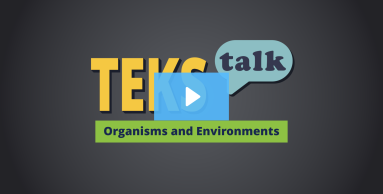
Knowledge and Skills Statement
As students observe a terrarium or aquarium, have them identify the living and nonliving components on a class T-chart. One example that students might observe in an aquarium is a fish hiding between two rocks in order to protect itself from another fish. Many aquariums also have a bubbler which adds oxygen to the water. If the aquarium students are observing has a bubbler, they might recognize that the fish interact with oxygen being provided by the bubbler and use it to breathe. An example of an interaction students might observe in a terrarium is a lizard sunbathing on a rock under the heat lamp. The lizard is using the warmth from the lamp and the rock to maintain a healthy body temperature.
Have students pair up and choose a component from both the living and nonliving list that interact and describe the interaction. In their notebooks, have students draw and label their chosen components, then write a sentence explaining how the components interact and how the living component depends on the non-living component. Students will mix-pair-share their chosen components and explanations.
The further explanation is designed to be a resource for educators that helps them better understand the topic their students are learning. Further explanations may be written at a more complex level than would be expected for students at the grade level.
An example of a food chain in words and in images is provided below
A food chain arranges the organisms in an ecological community according to the order of predation in which each uses the previous member as a food source; may include producers, herbivores, omnivores, and carnivores. As an educator, it is important to know that herbivores, omnivores, and carnivores are all referred to as consumers at this grade level.
Research
"Legaspi, Britt, and William Straits. “Living or Nonliving?” Science and Children 48, no. 8 (2011): 27–31.
http://www.jstor.org/stable/43176201.
Summary: Students often use their personal experience to determine whether or not something is living and may believe that all things can move and have feelings. This journal article outlines young students' common misconceptions about what classifies something as living or nonliving. The article suggests asking probing questions to see what students believe the criteria for living things are rather than just telling them the criteria. Students need to observe living and nonliving things first-hand and record and categorize what they see. As a class, students should discuss what living and nonliving they observed and try to find commonalities between the objects/organisms.

